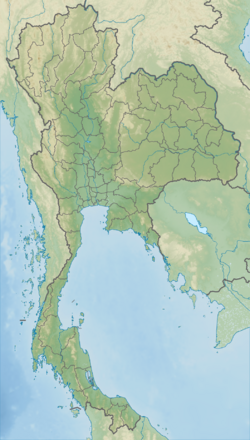Earth:Nam Phong Formation
| Nam Phong Formation Stratigraphic range: Late Triassic-Late Jurassic ~220–160 Ma | |
|---|---|
| Type | Geological formation |
| Underlies | Phu Kradung Formation |
| Overlies | Indosinian II Unconformity |
| Thickness | 1,465 m (4,806 ft) |
| Lithology | |
| Primary | Sandstone |
| Other | Conglomerate, siltstone, mudstone |
| Location | |
| Coordinates | [ ⚑ ] : 16°18′N 102°00′E / 16.3°N 102.0°E |
| Paleocoordinates | [ ⚑ ] 20°54′S 93°00′E / 20.9°S 93.0°E |
| Region | Isan |
| Country | |
| Extent | Khorat Plateau |
| Type section | |
| Named by | Ward & Bunnag |
| Year defined | 1964 |
The Nam Phong Formation, which correlates to the Indosinian III Unconformity, is a geological formation in Thailand. It underlies the Khorat Group. It consists of resistant, red-brown micaceous sandstones, conglomerates, siltstones and mudstones of mainly fluvial origin. The sandstones are medium to very fine-grained and are usually calcareous. The conglomerates contain pebbles of quartz, brown and grey chert, and reddish brown siltstone. Cross bedding and plane-bed stratification are common in the sandstones and conglomerates. The sandstones and conglomerates make up approximately 30% of the formation. This sedimentary rock formation is found in Khon Kaen Province, Thailand. It is of Norian to Rhaetian age (Upper Triassic) to (Lower Jurassic) age, and is notable for its fossils of early dinosaurs.[1]
Vertebrate paleofauna
Indeterminate prosauropod remains are present in Khon Kaen Province.[1]
| Vertebrates of the Nam Phong Formation | ||||||
|---|---|---|---|---|---|---|
| Genus | Species | Location | Stratigraphic position | Material | Notes | Images |
| Isanosaurus[1] | I. attavipachi[1] | Khon Kaen Province[1] | "Associated fragmentary vertebrae, ribs, chevrons, scapula, sternal, femur."[2] | |||
Correlations
The formation has been correlated with the Lower Elliot Formation (Karoo Basin) and Forest Sandstone of Africa, the Caturrita Formation of the Paraná Basin in Brazil, the Laguna Colorada and Los Colorados Formations (Ischigualasto-Villa Unión Basin) of Argentina, the Chinle Formation of North America, the Trössingen Formation of the Keuper Group of Germany, and the Lower Dharmaram Formation of India.[3]
See also
- List of dinosaur-bearing rock formations
References
Bibliography
- Novas, Fernando E.; Martín D. Ezcurra; Sankar Chatterjee, and T.S. Kutty. 2011. New dinosaur species from the Upper Triassic Upper Maleri and Lower Dharmaram formations of central India. Earth and Environmental Science Transactions of the Royal Society of Edinburgh 101. 333–349. Accessed 2019-04-06.doi:10.1017/S1755691011020093
- Weishampel, David B.; Peter Dodson, and Halszka Osmólska (eds.). 2004. The Dinosauria, 2nd edition, 1–880. Berkeley: University of California Press. Accessed 2019-02-21. ISBN:0-520-24209-2
 |


